 |
|
|
|
|
|
|
| ||||||||||
|
|
|
|
|
|
|
||||
| ||||||||||
|
|
|
|
|
Persons using assistive technology might not be able to fully access information in this file. For assistance, please send e-mail to: mmwrq@cdc.gov. Type 508 Accommodation and the title of the report in the subject line of e-mail. Youth Risk Behavior Surveillance --- Selected Steps Communities, 2005Nancy D. Brener, PhD,1 Laura Kann,
PhD,1 Danyael Garcia, MPH,2 Goldie MacDonald,
PhD,3 Fred Ramsey, MS,3 Sally Honeycutt,
MPH,2,4 Joseph Hawkins, MA,5 Steve
Kinchen,1 William A. Harris, MM1
Corresponding author: Nancy D. Brener, PhD, Division of Adolescent and School Health, National Center for Chronic Disease Prevention and Health Promotion, 4770 Buford Hwy, NE, MS K-33, Atlanta, GA 30341. Telephone: 770-488-6184; Fax: 770-488-6156; E-mail: nad1@cdc.gov. AbstractProblem: Unhealthy dietary behaviors, physical inactivity, and tobacco use contribute to chronic disease and other health conditions, including obesity, diabetes, and asthma. These behaviors often are established during childhood and adolescence, extend into adulthood, are interrelated, and are preventable. Reporting Period Covered: January--May 2005. Description of System: The Youth Risk Behavior Surveillance System (YRBSS) monitors priority health-risk behaviors, general health status, and the prevalence of overweight and asthma among youth and young adults. YRBSS includes a national school-based survey conducted by CDC and state and local school-based surveys conducted by state and local education and health agencies. As a component of YRBSS, in 2005, communities participating in the Steps to a HealthierUS Cooperative Agreement Program (Steps Program) also conducted school-based surveys of students in grades 9--12 in their program intervention areas. These communities used a modified core questionnaire that asks about dietary behaviors, physical activity, and tobacco use and monitors the prevalence of overweight, diabetes, and asthma. This report summarizes results from surveys of students in 15 Steps communities that conducted surveys in 2005. Results: Results from the 15 Steps communities indicated that a substantial proportion of adolescents engaged in health risk behaviors associated with obesity, diabetes, and asthma. During 2005, across surveys, the percentage of high school students who had not eaten fruits and vegetables >5 times/day during the 7 days preceding the survey ranged from 80.1% to 85.2% (median: 83.1%), the percentage who were overweight ranged from 6.6% to 19.6% (median: 11.5%), the percentage who did not attend physical education classes daily ranged from 53.7% to 95.1% (median: 74.2%), and the percentage who had smoked cigarettes during the 30 days preceding the survey ranged from 9.2% to 26.5% (median: 17.1%). Interpretation: Although the prevalence of many health-risk behaviors and health conditions varies across Steps communities, a substantial proportion of high school students engage in behaviors that place them at risk for chronic disease. Public Health Action: Steps Program staff at the national, tribal, state, and local levels will use YRBSS data for decision making, program planning, and enhancing technical assistance. These data will be used to focus existing programs on activities with the greatest promise of results, identify opportunities for strategic collaboration, and identify and disseminate lessons learned. IntroductionThe Steps to a HealthierUS Cooperative Agreement Program (Steps Program) is a national, multilevel chronic disease prevention effort coordinated by CDC. Through this program, Steps communities (i.e., small cities or rural areas whose activities are coordinated by a state health department, large cities or urban areas, and tribes or tribal entities) receive funds to implement chronic disease prevention and health promotion activities focused on reducing the burden of obesity, diabetes, and asthma and addressing three related risk behaviors: unhealthy dietary behaviors, physical inactivity, and tobacco use. To measure program outcomes and assess progress toward program goals, Steps communities participate in existing surveillance systems, including the Youth Risk Behavior Surveillance System (YRBSS). CDC developed YRBSS to monitor six categories of priority health-risk behaviors among youth and young adults, including behaviors that contribute to unintentional injuries and violence; tobacco use; alcohol and other drug use; sexual behaviors that contribute to unintended pregnancy and sexually transmitted diseases (STDs), including human immunodeficiency virus (HIV) infections; unhealthy dietary behaviors; and physical inactivity. In addition, YRBSS monitors general health status and the prevalence of overweight and asthma. YRBSS includes a national school-based survey conducted by CDC and state and local school-based surveys conducted by state and local education and health agencies; surveys have been conducted biennially since 1991. Steps communities participating in YRBSS use a modified core questionnaire that asks about dietary behaviors, physical activity, and tobacco use and monitors the prevalence of overweight, diabetes, and asthma. Participation in YRBSS provides community-level data regarding relevant risk behaviors; high-quality data that are comparable across Steps communities, states, and the nation; and a consistent, stable source of data that will enable programs to monitor progress. In fiscal year (FY) 2003, the Steps Program allocated $13.6 million to fund 12 programs representing 24 communities (including seven large [i.e., population >400,000] cities, one statewide tribal coalition, and four states that coordinated grants to 16 small cities and rural communities). This report summarizes results from the 15 Steps communities funded in FY 2003 that obtained weighted data for the 2005 YRBSS cycle and granted CDC permission to publish their data. Results from the community surveys with unweighted data are not included in this report. All weighted surveys were conducted during spring 2005. MethodsSamplingEach community school-based survey employed a two-stage cluster sample design to produce a representative sample of public school students in grades 9--12 in its program intervention area.* In the first sampling stage, all schools with any students in grades 9--12 were selected in 14 communities; in one community, schools with any students in grades 9--12 were selected with probability proportional to school enrollment size. In the second sampling stage, intact classes from either a required subject (e.g., English or social studies) or a required period (e.g., homeroom or second period) were selected randomly, and all students in selected classes were eligible to participate. Community surveys that had a scientifically selected sample of students, appropriate documentation, and an overall response rate of >60% were weighted. A weight was applied to each record to adjust for student nonresponse and the distribution of students by grade, sex, and race/ethnicity in each jurisdiction. Therefore, weighted estimates are representative of all students in grades 9--12 attending public schools in each Steps community. In 2005, a total of 15 communities had weighted data and granted permission to include their data in this report. Student sample sizes ranged from 836 to 1,661 (Table 1). School response rates ranged from 80% to 100%; student response rates ranged from 61% to 86%; and overall response rates, calculated by multiplying the school response rate by the student response rate, ranged from 60% to 86%. Eleven of the 15 communities for which results are provided in this report are small cities or rural communities, and four are large cities or urban communities. Race/ethnic distributions of students varied across communities (Table 1). In five communities, >80% of students are non-Hispanic white, in four communities, >50% of students are Hispanic, and in two communities, >50% of students are non-Hispanic black. For comparison purposes, this report also includes previously published data from the 2005 national school-based Youth Risk Behavior Survey (YRBS) (1). The sampling frame for the 2005 national YRBS consisted of all public and private schools with students in at least one of grades 9--12 in the 50 states and the District of Columbia. A three-stage cluster sample design produced a nationally representative sample of students in grades 9--12 who attended public and private schools. For the 2005 national YRBS, 13,953 questionnaires were completed in 159 schools. The school response rate was 78%, and the student response rate was 86%. The school response rate multiplied by the student response rate produced an overall response rate of 67%. Additional information about the national YRBS sample has been published previously (1). Data Collection Procedures and QuestionnaireProcedures for both the national and the Steps YRBS were designed to protect students' privacy by allowing for anonymous and voluntary participation. Before survey administration, local parental permission procedures were followed. Students completed the self-administered questionnaire during one class period and recorded their responses directly on a computer-scannable booklet or answer sheet. A detailed explanation of the YRBSS methodology and questionnaire development has been published previously (2). The national YRBS questionnaire contained 98 questions, and the core Steps questionnaire contained 39 of these questions and one question to monitor the prevalence of diabetes. Communities could add questions to the core questionnaire. Skip patterns were not included in any questionnaire to protect student privacy by ensuring that all students completed the questionnaire in approximately the same amount of time. Only data from core Steps questions are provided in this report. Information about the reliability of the core questions has been published previously (3). Data Processing and CodingThe national data set and each community data set were cleaned and edited for inconsistencies. Missing data were not imputed statistically. Of 13,953 completed questionnaires from the national YRBS, 36 failed quality control† and were excluded from analysis, leaving 13,917 usable questionnaires (Table 1). Among Steps community data sets, the number of completed questionnaires that failed quality-control checks and were excluded from analysis ranged from 2 to 18 (median: 6.5). On all community surveys, race/ethnicity was computed from answers to a single question: "How do you describe yourself?" Response options were "American Indian or Alaska Native," "Asian," "black or African American," "Hispanic or Latino," "Native Hawaiian or Other Pacific Islander," or "white." Students could select more than one response option. For this report, students were classified as "Hispanic" if they selected "Hispanic or Latino" only or if they selected "Hispanic or Latino" plus any other response option. Students were classified as "black" (i.e., non-Hispanic black) if they selected "black or African American" only. Students were classified as "white" (i.e., non-Hispanic white) if they selected "white" only. Students were classified as "other" if they selected "American Indian or Alaska Native," "Asian," or "Native Hawaiian or Other Pacific Islander" only or if they selected multiple response options other than "Hispanic or Latino." To determine the percentage of high school students who were overweight or at risk for becoming overweight, body mass index (kg/m2) (BMI) was calculated from self-reported height and weight. BMI values were compared to sex and age specific reference data from CDC's 2000 growth charts (4). Being at risk for becoming overweight was defined as having a BMI of >85th percentile and <95th percentile for age and sex. Overweight was defined as a BMI of >95th percentile for age and sex. A BMI of >95th percentile for age and sex among adolescents is approximately equivalent to a BMI of >30 among adults. For an adult, a BMI of 30 indicates that a person is approximately 30 pounds overweight. The reliability and validity of self-reported height and weight among high school students has been described previously (5). Analytic MethodsStatistical analyses were conducted on weighted data using SAS (6) and SUDAAN (7) software to account for the complex sampling designs. Prevalence estimates and confidence intervals were computed for all variables and all data sets. ResultsTobacco UseLifetime Cigarette Use Across surveys, the overall percentage of students who had ever smoked cigarettes, even one or two puffs (i.e., lifetime cigarette use) ranged from 38.7% to 65.5% (median: 51.1%). Prevalence among female students ranged from 35.3% to 64.9% (median: 49.9%), and prevalence among male students ranged from 41.9% to 69.3% (median: 51.8%) (Table 2). Lifetime Daily Cigarette Use Across surveys, the overall percentage of students who had ever smoked at least one cigarette every day for 30 days (i.e., lifetime daily cigarette use) ranged from 5.1% to 17.2% (median: 11.2%). Prevalence among female students ranged from 5.3% to 19.9% (median: 9.2%), and prevalence among male students ranged from 4.5% to 18.3% (median: 11.8%) (Table 2). Current Cigarette Use Across surveys, the overall percentage of students who had smoked cigarettes on >1 of the 30 days preceding the survey (i.e., current cigarette use) ranged from 9.2% to 26.5% (median: 17.1%). Prevalence among female students ranged from 6.9% to 24.4% (median: 15.3%), and prevalence among male students ranged from 9.7% to 33.4% (median: 15.4%) (Table 3). Current Frequent Cigarette Use Across surveys, the overall percentage of students who had smoked cigarettes on >20 of the 30 days preceding the survey (i.e., current frequent cigarette use) ranged from 1.9% to 11.3% (median: 5.9%). Prevalence among female students ranged from 1.6% to 12.2% (median: 4.8%), and prevalence among male students ranged from 1.8% to 12.5% (median: 7.2%) (Table 3). Smoked >10 Cigarettes/Day Across surveys, among students who reported current cigarette use, the overall percentage of students who had smoked >10 cigarettes/day on all days that they smoked ranged from 3.3% to 17.0% (median: 9.1%). Prevalence among female students ranged from 1.6% to 10.3% (median: 5.0%), and prevalence among male students ranged from 5.2% to 21.2% (median: 11.2%) (Table 3). Tried to Quit Smoking Cigarettes Across surveys, among students who reported current cigarette use, the overall percentage of students who had tried to quit smoking cigarettes during the 12 months preceding the survey ranged from 48.1% to 62.4% (median: 55.8%). Prevalence among female students ranged from 46.8% to 66.4% (median: 54.8%), and prevalence among male students ranged from 47.3% to 59.7% (median: 51.8%) (Table 4). Bought Cigarettes in a Store or Gas Station Across surveys, among students aged <18 years who reported current cigarette use, the overall percentage of students who usually obtained cigarettes by buying them in a store (e.g., a convenience store, supermarket, or discount store) or gas station during the 30 days preceding the survey ranged from 6.6% to 32.9% (median: 11.4%). Prevalence among female students ranged from 4.6% to 8.0% (median: 6.3%), and prevalence among male students ranged from 13.1% to 21.3% (median: 17.2%) (Table 4). Smoked a Whole Cigarette Before Age 13 Years Across surveys, the overall percentage of students who had smoked a whole cigarette for the first time before age 13 years ranged from 7.8% to 21.4% (median: 13.0%). Prevalence among female students ranged from 5.5% to 19.5% (median: 9.8%). Prevalence among male students ranged from 9.9% to 22.9% (median: 14.7%) (Table 5). Smoked Cigarettes on School Property Across surveys, the overall percentage of students who had smoked cigarettes on school property on >1 of the 30 days preceding the survey ranged from 2.2% to 8.7% (median: 4.7%). Prevalence among female students ranged from 1.6% to 7.9% (median: 4.1%), and prevalence among male students ranged from 2.3% to 9.5% (median: 5.8%) (Table 5). Dietary BehaviorsAte Fruits and Vegetables >5 Times a Day Across surveys, the overall percentage of students who had eaten fruits and vegetables§ five or more times a day during the 7 days preceding the survey ranged from 14.8% to 19.9% (median: 16.9%). Prevalence among female students ranged from 13.3% to 19.2% (median: 16.0%), and prevalence among male students ranged from 14.3% to 20.5% (median: 18.5%) (Table 6). Physical ActivityMet Currently Recommended Levels of Physical Activity Across surveys, the overall percentage of students who had been physically active doing any kind of physical activity that increased their heart rate and made them breathe hard some of the time for a total of >60 minutes/day on >5 of the 7 days preceding the survey (i.e., met currently recommended levels of physical activity) ranged from 19.2% to 43.2% (median: 34.0%). Prevalence among female students ranged from 13.4% to 34.2% (median: 27.9%), and prevalence among male students ranged from 25.8% to 52.2% (median: 41.9%) (Table 7). Met Previously Recommended Levels of Physical Activity Across surveys, the overall percentage of students who had participated in >20 minutes of vigorous physical activity (i.e., physical activity that made them sweat and breathe hard) on >3 of the 7 days preceding the survey and/or >30 minutes of moderate physical activity (i.e., physical activity that did not make them sweat and breathe hard) on >5 of the 7 days preceding the survey (i.e., met previously recommended levels of physical activity) ranged from 45.4% to 79.8% (median: 71.7%). Prevalence among female students ranged from 39.5% to 76.8% (median: 66.7%), and prevalence among male students ranged from 52.1% to 83.1% (median: 76.3%) (Table 7). No Vigorous or Moderate Physical Activity Across surveys, the overall percentage of students who had not participated in any vigorous or moderate physical activity during the 7 days preceding the survey ranged from 3.8% to 23.5% (median: 6.0%). Prevalence among female students ranged from 3.0% to 29.6% (median: 7.3%), and prevalence among male students ranged from 3.8% to 17.1% (median: 5.3%) (Table 7). Watched Television for >3 Hours/Day Across surveys, the overall percentage of students who watched television for >3 hours per day on an average school day ranged from 22.9% to 55.0% (median: 34.5%). Prevalence among female students ranged from 20.8% to 59.9% (median: 33.3%), and prevalence among male students ranged from 21.8% to 50.4% (median: 34.4%) (Table 8). Used Computers for >3 Hours/Day Across surveys, the overall percentage of students who played video or computer games or used a computer for something that was not school work for >3 hours per day on an average school day ranged from 11.6% to 24.7% (median: 17.5%). Prevalence among female students ranged from 7.0% to 20.7% (median: 11.5%), and prevalence among male students ranged from 16.3% to 29.7% (median: 24.8%) (Table 8). Attended Physical Education Classes Across surveys, the overall percentage of students who attended physical education (PE) classes on >1 day(s) in an average week when they were in school (i.e., attended PE classes) ranged from 32.9% to 98.5% (median: 50.9%). Prevalence among female students ranged from 28.7% to 98.9% (median: 42.5%), and prevalence among male students ranged from 37.2% to 98.1% (median: 59.4%) (Table 9). Attended Physical Education Classes Daily Across surveys, the overall percentage of students who attended PE classes 5 days in an average week when they were in school (i.e., attended PE classes daily) ranged from 4.9% to 46.3% (median: 25.8%). Prevalence among female students ranged from 1.7% to 41.3% (median: 22.5%), and prevalence among male students ranged from 3.9% to 53.7% (median: 29.3%) (Table 9). Exercised or Played Sports >20 Minutes During an Average PE Class Across surveys, among students who attended PE classes, the percentage of students who actually exercised or played sports >20 minutes during an average PE class ranged from 56.4% to 92.3% (median: 85.7%). Prevalence among female students ranged from 50.3% to 94.5% (median: 83.7%), and prevalence among male students ranged from 61.9% to 93.2% (median: 86.3%) (Table 9). Played on One or More Sports Teams Across surveys, the overall percentage of students who had played on at least one sports team (run by their school or community groups) during the 12 months preceding the survey ranged from 44.1% to 64.1% (median: 54.5%). Prevalence among female students ranged from 33.1% to 61.6% (median: 51.8%), and prevalence among male students ranged from 51.1% to 67.1% (median: 59.6%) (Table 10). Injured While Exercising or Playing Sports Across surveys, among students who exercised or played sports during the 30 days preceding the survey, the overall percentage of students who had had to see a doctor or nurse for an injury that happened while exercising or playing sports ranged from 12.9% to 21.7% (median: 16.7%). Prevalence among female students ranged from 10.5% to 20.4% (median: 15.9%), and prevalence among male students ranged from 12.3% to 24.3% (median: 17.6%) (Table 10). Overweight and Weight ControlAt Risk for Becoming Overweight Across surveys, the overall percentage of students who were at risk for becoming overweight (i.e., >85th percentile but <95th percentile for BMI, by age and sex, on the basis of reference data) ranged from 7.9% to 19.7% (median: 14.8%) (Table 11). Prevalence among female students ranged from 6.1% to 21.7% (median: 13.6%), and prevalence among male students ranged from 9.6% to 20.5% (median: 15.4%) (Table 11). Overweight Across surveys, the overall percentage of students who were overweight (i.e., >95th percentile for BMI, by age and sex, on the basis of reference data) ranged from 6.6% to 19.6% (median: 11.5%). Prevalence among female students ranged from 3.5% to 14.9% (median: 7.2%), and prevalence among male students ranged from 9.5% to 25.4% (median: 15.5%) (Table 11). Described Themselves as Overweight Across surveys, the overall percentage of students who described themselves as slightly or very overweight ranged from 20.8% to 36.1% (median: 30.0%). Prevalence among female students ranged from 24.3% to 42.1% (median: 35.3%), and prevalence among male students ranged from 16.4% to 30.3% (median: 23.9%) (Table 12). Were Trying to Lose Weight Across surveys, the overall percentage of students who were trying to lose weight ranged from 36.5% to 52.9% (median: 44.6%). Prevalence among female students ranged from 44.3% to 65.6% (median: 60.0%), and prevalence among male students ranged from 17.9% to 41.0% (median: 30.1%) (Table 12). Ate Less Food, Fewer Calories, or Foods Low in Fat to Lose Weight or Keep from Gaining Weight Across surveys, the overall percentage of students who had eaten less food, consumed fewer calories, or eaten foods low in fat to lose weight or keep from gaining weight during the 30 days preceding the survey ranged from 31.2% to 44.2% (median: 37.9%). Prevalence among female students ranged from 35.2% to 54.3% (median: 50.4%), and prevalence among male students ranged from 18.2% to 35.7% (median: 26.1%) (Table 13). Exercised to Lose Weight or Keep From Gaining Weight Across surveys, the overall percentage of students who had exercised to lose weight or keep from gaining weight during the 30 days preceding the survey ranged from 48.6% to 70.6% (median: 62.6%). Prevalence among female students ranged from 49.0% to 74.6% (median: 70.5%), and prevalence among male students ranged from 43.3% to 68.1% (median: 53.0%) (Table 13). Went Without Eating for >24 Hours to Lose Weight or Keep From Gaining Weight Across surveys, the overall percentage of students who had gone without eating for >24 hours to lose weight or keep from gaining weight during the 30 days preceding the survey ranged from 7.4% to 18.5% (median: 9.6%) (Table 14). Prevalence among female students ranged from 10.0% to 19.6% (median: 12.7%), and prevalence among male students ranged from 3.7% to 19.1% (median: 6.8%) (Table 14). Took Diet Pills, Powders, or Liquids to Lose Weight or Keep from Gaining Weight Across surveys, the overall percentage of students who had taken diet pills, powders, or liquids without a doctor's advice to lose weight or keep from gaining weight during the 30 days preceding the survey ranged from 3.7% to 10.2% (median: 5.6%). Prevalence among female students ranged from 3.8% to 10.0% (median: 5.9%), and prevalence among male students ranged from 2.4% to 11.8% (median: 4.7%) (Table 14). Vomited or Took Laxatives to Lose Weight or to Keep from Gaining Weight Across surveys, the overall percentage of students who had vomited or taken laxatives to lose weight or keep from gaining weight during the 30 days preceding the survey ranged from 3.3% to 9.9% (median: 4.3%). Prevalence among female students ranged from 4.0% to 10.5% (median: 5.2%), and prevalence among male students ranged from 1.7% to 11.1% (median: 2.8%) (Table 14). Other Health-Related TopicsLifetime Asthma Across surveys, the overall percentage of students who had ever been told by a doctor or nurse that they had asthma (i.e., lifetime asthma) ranged from 15.5% to 27.9% (median: 20.1%). Prevalence among female students ranged from 11.9% to 25.8% (median: 20.3%), and prevalence among male students ranged from 15.1% to 30.3% (median: 20.4%) (Table 15). Current Asthma Across surveys, the overall percentage of students with lifetime asthma who reported having either 1) asthma but no episode or attack or 2) an asthma episode or attack (i.e., current asthma) during the 12 months preceding the survey ranged from 10.9% to 19.7% (median: 15.9%). Prevalence among female students ranged from 9.4% to 21.5% (median: 16.9%), and prevalence among male students ranged from 10.4% to 18.2% (median: 15.5%) (Table 15). Asthma Episode or Attack Across surveys, the overall percentage of students with current asthma who had an asthma episode or attack during the 12 months preceding the survey ranged from 28.4% to 52.4% (median: 37.6%). Prevalence among female students ranged from 37.4% to 48.1% (median: 44.9%), and prevalence among male students ranged from 24.5% to 37.8% (median: 28.4%) (Table 15). Lifetime Diabetes Across surveys, the overall percentage of students who had ever been told by a doctor or nurse that they had diabetes (i.e., lifetime diabetes) ranged from 1.9% to 4.8% (median: 3.2%). Prevalence among female students ranged from 0.7% to 5.5% (median: 2.3%), and prevalence among male students ranged from 1.8% to 5.7% (median: 3.8%) (Table 16). Described Health as Fair or Poor Across surveys, the overall percentage of students who described their health, in general, as fair or poor ranged from 7.3% to 13.1% (median: 9.3%). Prevalence among female students ranged from 8.0% to 16.0% (median: 10.8%), and prevalence among male students ranged from 4.9% to 12.1% (median: 8.3%) (Table 16). DiscussionThe median prevalence of risk behaviors across Steps communities was within 5 percentage points of the national estimate from the 2005 national YRBS (1) for all but three behaviors: current cigarette use (median: 17.1%; national estimate: 23.0 ± 2.3%), attended PE classes daily (median: 25.8%; national estimate: 33.0 ± 5.3%), and injured while exercising or playing sports (median: 16.7%; national estimate: 22.2 ± 1.3%). Lifetime diabetes was not measured in the national YRBS, so how the median prevalence across Steps communities compares with the national estimate of self-reported lifetime diabetes among high school students is unknown. Across communities, prevalence did not vary substantially for approximately two thirds of risk behaviors included in the Steps questionnaire. However, a range of >25 percentage points or a fivefold variation or greater was identified for the following risk behaviors:
In part, these variations might reflect differences in state and local laws and policies, enforcement practices, availability of effective school and community interventions, prevailing behavioral and social norms, demographic characteristics of the population, and adult practices. Ongoing YRBSS data collected in these communities will enable Steps Program staff and other public health and education officials to assess change in these behaviors over time, providing one method of evaluating the effectiveness of those communities' Steps Programs. LimitationsThe findings in this report are subject to at least four limitations. First, these data apply only to youth who attended school during 2005 and therefore are not representative of all persons in this age group in each community. Nationwide, in 2004, of persons aged 16--17 years, approximately 4% were not enrolled in a high school program and had not completed high school (8). Second, although the national YRBS includes private schools, Steps surveys do not, making comparison between the national and community data imperfect. Third, the extent of underreporting or overreporting of behaviors cannot be determined, although the survey questions demonstrate good test-retest reliability (3). Finally, because BMI was calculated on the basis of self-reported height and weight, the prevalence of overweight and for being at risk for becoming overweight might be underestimated (5). ConclusionYRBSS data collected in Steps communities will be used by Steps Program staff at the national, tribal, state, and local levels to examine whether the program is having intended effects on target audiences. In addition, Steps Program staff will use these data for decision making, program planning, and enhancing technical assistance. YRBSS data will be used by Steps Program staff to focus existing programs on activities with the greatest promise of results, identify opportunities for strategic collaboration, and identify and disseminate lessons learned. References
* Data from two large cities/urban communities included in this report (Boston and New Orleans) also are included in a previous report (1). The data for the Boston Steps community is a subset of the Boston Public Schools data published previously, whereas the New Orleans data are identical to those published previously. † For questionnaires containing <50 questions, those that failed quality control had <15 remaining responses after editing or had the same answer to >12 questions in a row. For questionnaires containing >50 questions, those that failed quality control had <20 remaining responses after editing or had the same answer to >15 questions in a row. § Refers to 100% fruit juice, green salad, potatoes (excluding french fries, fried potatoes, or potato chips), carrots, or other vegetables. Table 1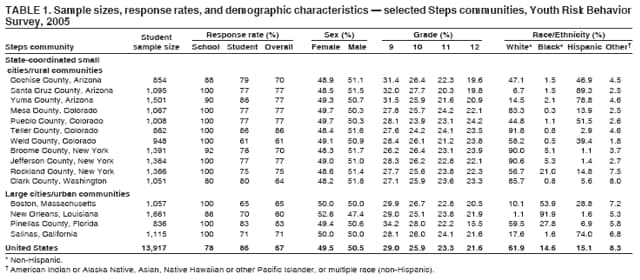 Return to top. Table 2 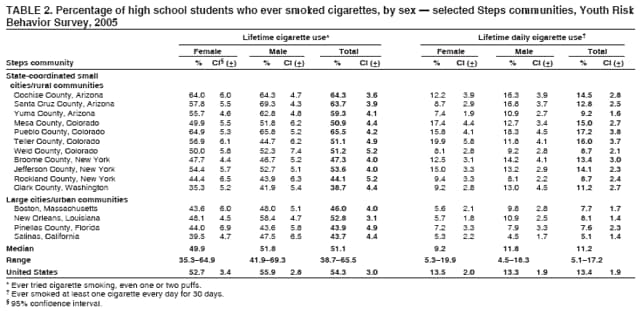 Return to top. Table 3 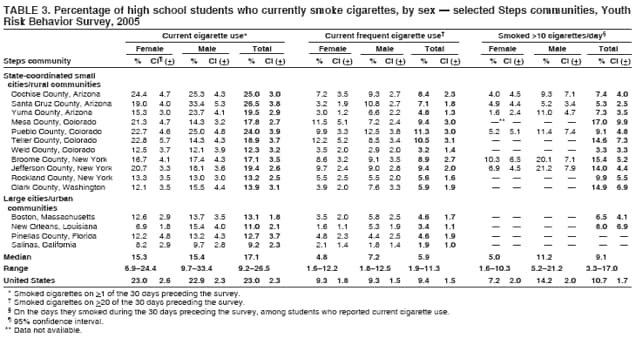 Return to top. Table 4 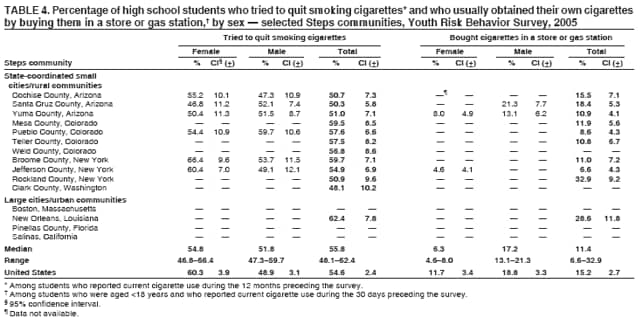 Return to top. Table 5 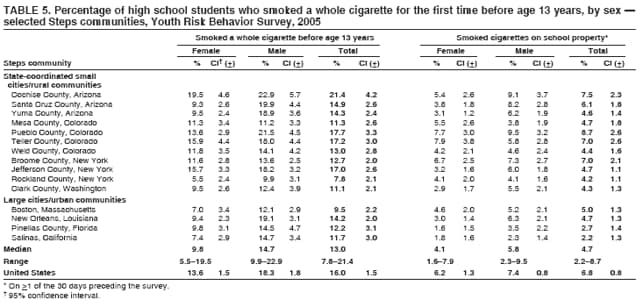 Return to top. Table 6  Return to top. Table 7 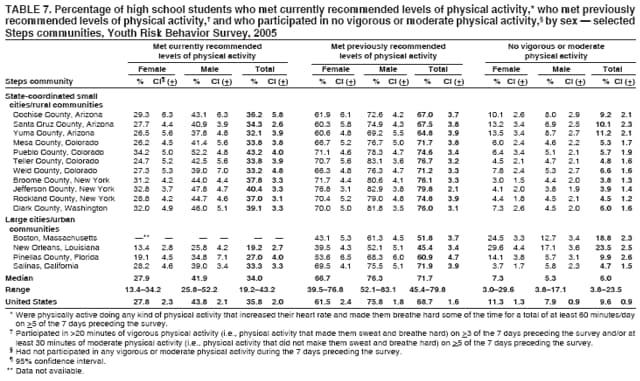 Return to top. Table 8 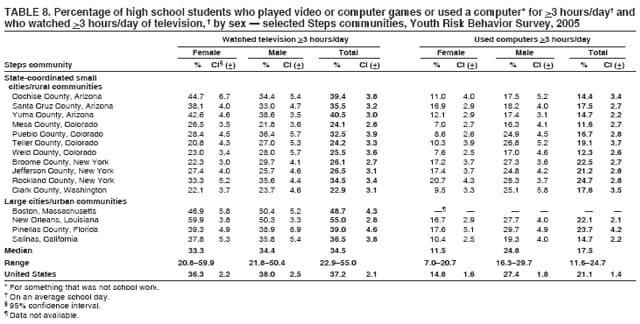 Return to top. Table 9  Return to top. Table 10  Return to top. Table 11 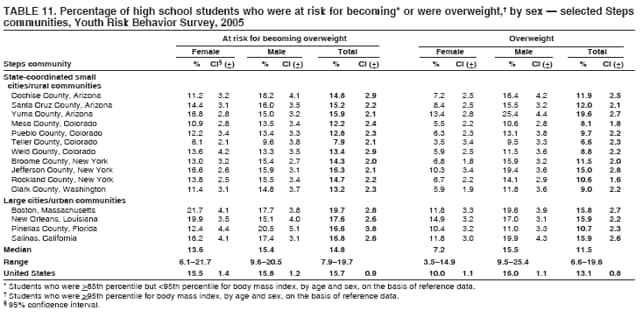 Return to top. Table 12  Return to top. Table 13 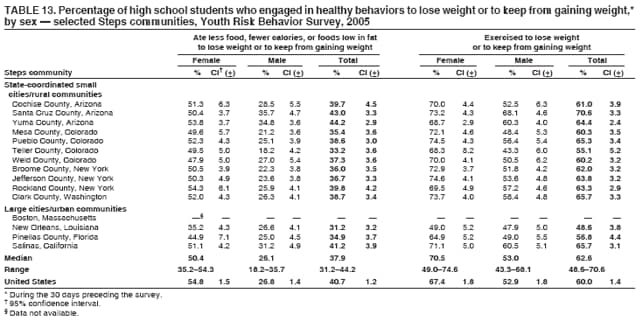 Return to top. Table 14 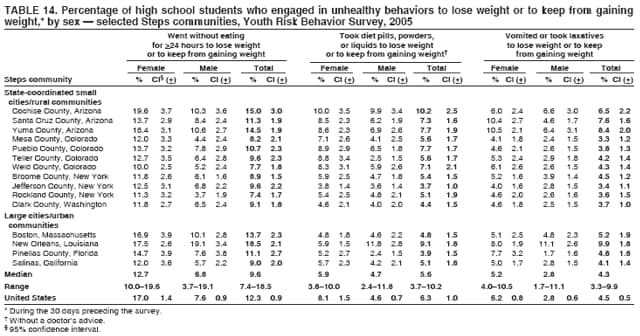 Return to top. Table 15 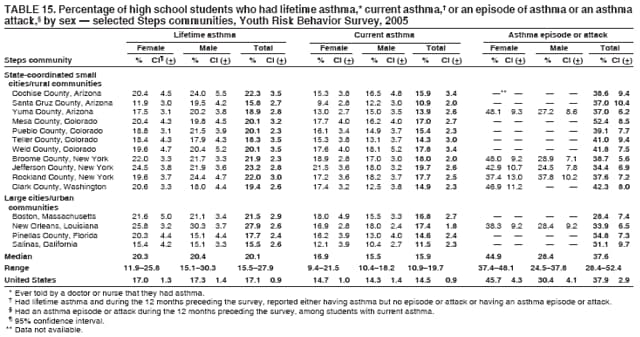 Return to top. Table 16 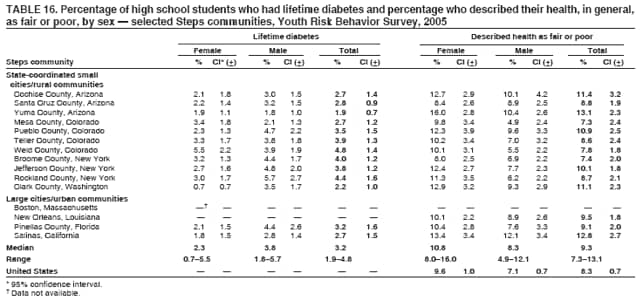 Return to top.
Disclaimer All MMWR HTML versions of articles are electronic conversions from ASCII text into HTML. This conversion may have resulted in character translation or format errors in the HTML version. Users should not rely on this HTML document, but are referred to the electronic PDF version and/or the original MMWR paper copy for the official text, figures, and tables. An original paper copy of this issue can be obtained from the Superintendent of Documents, U.S. Government Printing Office (GPO), Washington, DC 20402-9371; telephone: (202) 512-1800. Contact GPO for current prices. **Questions or messages regarding errors in formatting should be addressed to mmwrq@cdc.gov.Date last reviewed: 1/31/2007 |
|||||||||
|